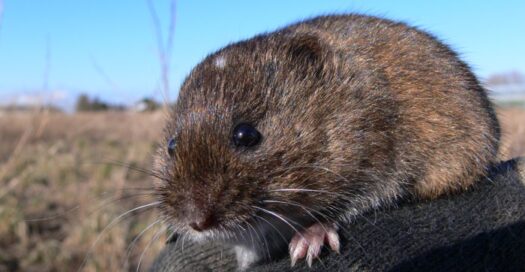Townsend's Vole
The Townsend’s vole is a rodent known to thrive throughout wetlands and grassland meadows. Though considered one of the largest vole species around, adults typically weigh between 47 and 82.5 grams, and extend to a maximum length of 24 centimeters (9 inches).
Their fur is dark brown in colour and often tipped with black, while their bellies are dull grey, and they have medium sized ears.
Townsend’s Voles can be found as far north as Triangle Island (a small island north of Vancouver Island), east to Chilliwack, and south to northern California.

Hedgerows, Grassland Set-asides, and old fields are prime habitats for Townsend’s voles and they are up to eight times more abundant in grassland set-asides than in forage fields.
Their capability to reproduce every few weeks between April to October each year, as well as their large litter size of up to nine young per female, make Townsend’s Voles prime candidates for “pest” status on agricultural land. Feeding on the roots of grasses, sedges, and other soft-stemmed plants, as well as fallen seeds and leaves, these voles can chew away quickly at a farmer’s crop.
Luckily, their presence attracts many local predators which are drawn to the voles’ activity both day and night, including some threatened species such as the Short-eared Owl and the Barn Owl. Other species for which the Townsend’s Vole is of significant importance include Snowy Owls, Northern Harriers, Rough-legged Hawks, and many other raptors, as well as Great Blue Herons, American Bitterns, and Coyotes.
One tell-tale sign that a Townsend’s Vole is in the area is the presence of tunnels through vegetation along the ground; these runways are often used throughout many generations of voles and can extend down to five centimeters deep. They spend a great deal of time in their underground burrows where they create an extensive system of traveling, feeding, and nesting corridors overlapping one another.
Their burrowing habits also assist in increasing soil aeration. Despite what many may think, Townsend’s Voles are impressive swimmers and they will often readily dive into water. In fact, to better escape some predators, they will often make the entrance to their summer burrows underwater.
How Can You Help?
Your donation will work towards conserving important farmland and wildlife resources contained in the Fraser River delta.
